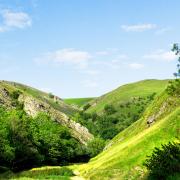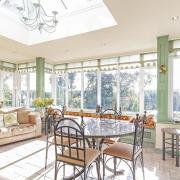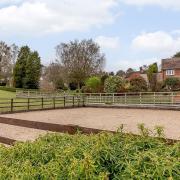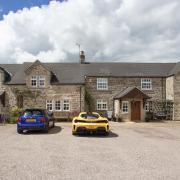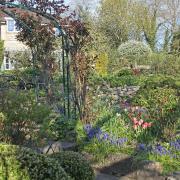Thousands enjoyed visiting the gardens at Fanshawe Gate, near Holmesfield, this summer. Pat Ashworth returns to find out how the family celebrates Christmas at Fanshawe Gate Hall
For every year bar one of the 50 they have been there, John and Cynthia Ramsden have been gathering family and friends about them for carols and mulled wine on Christmas Eve at Fanshawe Gate Hall.
‘It’s a house that does lend itself to Christmas,’ acknowledges Cynthia. On that one occasion when the couple were not able to be there – they were given coveted tickets for the Festival of Nine Lessons and Carols at Kings College, Cambridge – their son, Mark, held the phone out to them so they could hear the festive tradition being kept up in their absence. Cynthia confesses that it moved her to tears.
Her work and passion for the gardens at Fanshawe Gate is well documented, not least in her own book, A Garden in my Life and in its recently published sequel, Garden Tales, both in aid of charities supported by the National Gardens Scheme and the Oesophageal Patients Association. It is one of the most beautiful and best-loved private gardens in Derbyshire, attracting thousands of visitors on open days for the National Gardens Scheme. But the story of the house is equally inspiring, especially as the family have done the bulk of the work themselves.
‘If you live in a house like Fanshawe Gate, you have to be either wealthy or practical, and we are the latter,’ Mark Ramsden has remarked. The house dates back to 1260 and remained in the Fanshawe family until 1944. It had deteriorated intoa tumbledown, decrepit farmstead, and when John and Cynthia moved here from Ecclesall in 1959, there was everything to do to turn it into a home for what became a family of five children.
To the visitor seeing it for the first time, it gives every impression of being a house that was simply ready to move into, looking every bit as it might have looked in its Tudor heyday. We are sitting in what has become known as the snug, with winter sunlight streaming through eccentric windows, logs crackling in the fire, well-thumbed books jostling on the shelves and an enticing plate of Cynthia’s trademark Anzac biscuits and Viennese Whirls.
But when the family moved in, this room had been a potato store adjacent to a single-storey lean-to. It needed to become a kitchen in place of the existing impractical farmhouse kitchen with its huge and smoking Yorkshire range and walls blue-washed to stop the flies and keep things cool.
Stonework and mullions everywhere had been covered with a thick gloss paint, which all had to be scraped off with a table knife. There’s a similar story behind the big stone fireplace in the chimney breast in the snug, which looks for all the world as though it was part of the original structure but was in fact rescued from a house on the High Street in Dronfield which might well have been owned by a relative. It arrived ‘black, covered in thick kiln dust and tar,’ Cynthia remembers with a shudder. ‘Nicola [her eldest daughter] and I just chipped and chipped and chipped away at it...’
The family exposed and cleaned up the beams and excavated spaces between walls that proved to be several feet thick. The only sign now that this was once Cynthia’s kitchen is a remnant that mystifies guests: a quirky set of locker-sized cupboards that John built into one of the recesses, which still house tins of groceries and jars of jam. ‘There are things in here that should be in the kitchen and things in the kitchen that should be in the snug, but that’s because the room that is now the kitchen is tiny, purely a working kitchen,’ she says with a smile, knowing it defies logic to anyone who doesn’t live with it.
The first kitchen evolved into the snug when the children and their friends became teenagers and crowded it out while she was trying to prepare Sunday lunch. The new kitchen was located in an extension which had replaced the demolished lean-to, linked to the main house by an archway using old stones and mullions so that it neatly blended with the original. Such an old house is full of oddities and inventive solutions. A ramped floor that crosses into what was the farmhouse kitchen but is now the dining room is in effect a bridge over the cellars, accessed by a trapdoor and flight of worn stone steps.
Here, the foundations of the original house are visible; a blocked-up arched doorway, small mullion windows, a vaulted ceiling and an old trough too heavy ever to be moved. An ancient stone drain runs through the cellars and the family have cause to be thankful that the water table is lower than once it was. ‘In the old days, it used to flood with heavy rainfall. We lost two central heating boilers and used to have a permanent submersible pump down here,’ Cynthia remembers.
The dining room is the oldest part of the house and still has hooks on the beams where lanterns were hung. Mullioned windows on two sides yield stunning views of the adjoining fields and the valley below; the third reveals the glories of the garden. ‘John says we will all get this medieval stoop,’ says Cynthia, as we duck under the arch leading to the hallway. It’s hard to believe that this tall and elegant space, where you crane your neck to see up the spiral iron staircase to the vaulted roof, was a dark and ugly area, boxed-in with hardboard panels in the 1930s and lacking all grace.
‘We took the ceiling down, all the way to the top, tidied all the beams and cleaned them up,’ Cynthia says, as casually as if it were no feat at all. Ask her in wonder how they did all this work on the house, most of it themselves, and she says simply, ‘We were young in those days and I don’t mind muck and mess. It was all very exciting.’ They discovered a burned roof beam that was literally freestanding, and John had rapidly to find and insert a corbel.
A ladder served as access to the upper floor until they were able to put in the staircase. They restored a blocked-up window too, provided by neighbours at Woodthorpe Hall. It looks quite at home and might even have come from there, since archives from the Duke of Rutland show Woodthorpe Hall to have been built from the stone and timber of a demolished part of Fanshawe Gate Hall.
The stone flagged floor in the sunny dining room has its own story to tell. Archaeologists and historians suggest that the Hall and the cottage which belongs to it were originally at the opposite sides of what before the 1800s may have been a much taller building. That theory was vindicated when Cynthia came to put in the topiary outside and discovered the same stone flags there beneath the surface in the courtyard.
Upstairs, the original five bedrooms have become three. The low corridor winds and twists. ‘Friends tease us, “How are you going to get a coffin down here?” but John’s got it all sussed,’ says Cynthia with a laugh. She frowns at a miniscule cobweb – ‘I do my housework in the winter and the garden in the summer, but with the book launch and one thing and another...’ and rummages in a drawer in the bedroom for a photograph of the Victorian fireplace that proved on excited excavation at 2am one morning to hide a much earlier and finer chimney breast.
A splendid four poster bed dominates the guest room, where the old nursery has become a dressing room. They took the ceiling down in here too to expose the beams: a family effort that required two sons to be up on the roof itself and the rest of the family below. Pride of place on the wall goes to a portrait of Sir Henry Fanshawe, founder in 1579 of Dronfield Grammar School, where John and Cynthia met and where John was chairman of governors.
The school presented him with the picture when he retired. A former director of an insurance company, a liveryman and freeman of the City of London, he was awarded the CBE in 1988. Also an Alderman and three times a parliamentary candidate, John made a commitment 12 years ago when Cynthia was undergoing treatment for cancer, that he would dedicate himself to whatever life she wanted to lead after her recovery. A staunch Anglican, he is a trustee of the sixteenth century trust that owns Holmesfield Church, where the family worships, and also a lay preacher. ‘When times were most stressful, it was wonderful to be able to go out to a small parish in Derbyshire to take the evening service,’ he says.
We move across the lawn to the cottage, which was a stable and hayloft when they moved in. Now it accommodates guests and houses John’s office. The family has restored and renovated the mediaeval dovecote too, a precious feature that might have disappeared. ‘At a time when they weren’t listed, some Americans offered a terrific amount of money for the dovecote and gateposts, to ship them back home,’ Cynthia says in horror.
Guests who come regularly to stay in the cottage include Simon Fanshawe, head of the senior branch of the family, and his wife, Jan. They love the place and use it as a base for walking in the Peak. ‘It’s not just a place I visit. I wouldn’t go so far as to say it’s like coming home but I have a definite feeling of belonging when I come here: some sort of instinctive association with the place. I sometimes try to imagine what it might have looked like in the sixteenth and seventeenth centuries, when the family was growing in power and influence,’ Simon reflects in Garden Tales.
The new, beautifully illustrated book is a tribute to all the volunteers who work to make the garden open days such a resounding success. A colourful parade of family, friends, doctors, teachers, nurses, artists, tell in their own words what the house and garden mean to them. But more than that, it’s a fascinating snapshot of life in this area of Derbyshire and of the triumphs and tragedies of twentieth century people: a piece of social history in itself.
The last word in the book goes to Arry the Cockerel, rescued by Cynthia from Death Row. ‘Being a cockerel with a smattering of historical and literary knowledge, I live by the philosophy of Sir Richard Fanshawe [1608–1666], whose family built the place I now call home,’ he asserts. Sir Richard’s poem, ‘Of Beauty’ remains ‘good advice for both humans and cockerels,’ he suggests.
Let us use it while we maySnatch those joys that haste away!Earth her winter coat may cast,And renew her beauty past;But, our winter come, in vainWe solicit spring again;And when our furrows snow shall cover,Love may return but never lover.
To which John and Cynthia would certainly say, Amen.
Cynthia and her daughter Nicola will be talking about Garden Tales at the Country Bookshop in Hassop on 30th November, 6.30pm. Details of how to order Garden Tales or A Garden in my Life are on: www.fanshawegate.com and also on www.grafika-uk.com



